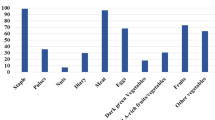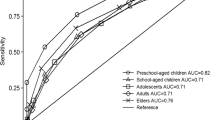Abstract
Purpose
In low-income settings, dietary diversity scores (DDSs) often predict the micronutrient adequacy of diets, but little is known about whether they predict levels of biochemical indicators of micronutrient status.
Methods
In 2010, we studied two samples of non-pregnant 14- to 19-year-old girls in central Mozambique, the first in January–February (‘hunger season’; n = 227) and the second in May–June (harvest season; n = 223). In this paper, we examined whether a low Women’s Dietary Diversity Score (WDDS) predicts a low concentration of haemoglobin, serum ferritin, zinc, and folate, and plasma retinol in adolescent Mozambican girls. We constructed three scores: WDDS based on 24-h recalls, WDDS15g based on 24-h recall and employing a 15 g limit, and 7dWDDS based on 7-day food frequency questionnaires. Logistic regression models, stratified by season, were used to estimate the odds of having a low concentration of a status indicator (≤25th percentile of the season-specific distribution or cut-off from the literature) in those with a low score compared to those with a higher score.
Results
In January–February, after adjusting for confounders, a low (≤3) WDDS and a low (≤5) 7dWDDS were each associated with higher odds of having low serum zinc compared to having a higher score, regardless of which of the two types of cut-offs for serum zinc was used. These associations were not present in May–June.
Conclusions
Our data from Mozambique suggest that dietary diversity is associated with serum zinc, but this association seems to be limited to the hunger season.

Similar content being viewed by others
References
Ruel MT (2003) Operationalizing dietary diversity: a review of measurement issues and research priorities. J Nutr 133:3911S–3926S
FAO (2014) Food-based dietary guidelines: food guidelines by country. http://www.fao.org/ag/humannutrition/nutritioneducation/fbdg/en/. Accessed Dec 2014
Ogle BM, Hung PH, Tuyet HT (2001) Significance of wild vegetables in micronutrient intakes of women in Vietnam: an analysis of food variety. Asia Pac J Clin Nutr 10:21–30
Torheim LE, Ouattara F, Diarra MM, Thiam FD, Barikmo I, Hatløy A et al (2004) Nutrient adequacy and dietary diversity in rural Mali: association and determinants. Eur J Clin Nutr 58:594–604
Savy M, Martin-Prevel Y, Traissac P, Delpeuch F (2007) Measuring dietary diversity in rural Burkina Faso: comparison of a 1-day and a 3-day dietary recall. Public Health Nutr 10:71–78
Arimond M, Wiesmann D, Becquey E, Carriquiry A, Daniels MC, Deitchler M et al (2010) Simple food group diversity indicators predict micronutrient adequacy of women’s diets in 5 diverse, resource-poor settings. J Nutr 140:2059S–2069S
Arsenault JE, Yakes EA, Islam MM, Hossain MB, Ahmed T, Hotz C et al (2013) Very low adequacy of micronutrient intakes by young children and women in rural Bangladesh is primarily explained by low food intake and limited diversity. J Nutr 143:197–203
Rose D, Meershoek S, Ismael C, McEwan M (2002) Evaluation of a rapid field tool for assessing household diet quality in Mozambique. Food Nutr Bull 23:181–189
Steyn NP, Nel J, Labadarios D, Maunder EMW, Kruger HS (2014) Which dietary diversity indicator is best to assess micronutrient adequacy in children 1 to 9 y? Nutrition 30:55–60
Steyn NP, Nel JH, Nantel G, Kennedy G, Labadarios D (2006) Food variety and dietary diversity scores in children: are they good indicators of dietary adequacy? Public Health Nutr 9:644–650
Wiesmann D, Arimond M, Loechl C (2009) Dietary diversity as a measure of the micronutrient adequacy of women’s diets: results from rural Mozambique site. Food and Nutrition Technical Assistance II Project, Academy for Educational Development, Washington, D.C. http://www.fantaproject.org/sites/default/files/resources/WDDP_Mozambique_Dec09.pdf, http://www.webcitation.org/6VYDKeWKz. Accessed Dec 2014
Kennedy G, Ballard T, Dop M (2010) Guidelines for measuring household and individual dietary diversity. FAO. http://www.fao.org/3/f31af845-f69c-5aa8-bfb4-04dea6b98e1d/i1983e00.pdf, http://www.webcitation.org/6UgtuQGHB. Accessed Dec 2014
Gebreselassie SG, Gase FE, Deressa MU (2013) Prevalence and correlates of prenatal vitamin A deficiency in rural Sidama, Southern Ethiopia. J Health Popul Nutr 31:185–194
Fujita M, Lo Y-J, Baranski JR (2012) Dietary diversity score is a useful indicator of vitamin A status of adult women in Northern Kenya. Am J Hum Biol 24:829–834
Gebremedhin S, Enquselassie F, Umeta M (2011) Prevalence of prenatal zinc deficiency and its association with socio-demographic, dietary and health care related factors in rural Sidama, Southern Ethiopia: a cross-sectional study. BMC Public Health 11:898. doi:10.1186/1471-2458-11-898
Korkalo L, Freese R, Alfthan G, Fidalgo L, Mutanen M (2015) Poor micronutrient intake and status is a public health problem among adolescent Mozambican girls. Nutr Res 35:664–673
Korkalo L, Freese R, Fidalgo L, Selvester K, Ismael C, Mutanen M (2014) A cross-sectional study on the diet and nutritional status of adolescent girls in Zambézia Province, Mozambique (the ZANE Study): design, methods, and population characteristics. JMIR Res Protoc 3:e12. doi:10.2196/resprot.3109
FAO (2015) A brand new global dietary diversity indicator for women [web page]. http://www.webcitation.org/6czEcMWVG. Accessed Nov 2015
WHO (2011) Haemoglobin concentrations for the diagnosis of anaemia and assessment of severity. http://www.who.int/vmnis/indicators/haemoglobin/en/. Accessed Apr 2014
WHO (2011) Serum ferritin concentrations for the assessment of iron status and iron deficiency in populations. http://www.who.int/vmnis/indicators/ferritin/en/. Accessed Apr 2014
International Zinc Nutrition Consultative Group (IZiNCG), Brown KH, Rivera JA, Bhutta Z, Gibson RS, King JC et al (2004) International Zinc Nutrition Consultative Group (IZiNCG) technical document #1. assessment of the risk of zinc deficiency in populations and options for its control. Food Nutr Bull 25:S99–S203
WHO (2011) Serum retinol concentrations for determining the prevalence of vitamin A deficiency in populations. http://www.who.int/vmnis/indicators/retinol/en/. Accessed Apr 2014
WHO (2012) Serum and red blood cell folate concentrations for assessing folate status in populations. http://www.who.int/vmnis/indicators/serum_RBC_folate/en/. Accessed Apr 2014
Myers TA (2011) Goodbye, listwise deletion: presenting hot deck imputation as an easy and effective tool for handling missing data. Commun Methods Meas 5:297–310
Lumley T (2013) Survey: analysis of complex survey samples. R package version 3.29-5. http://cran.r-project.org/web/packages/survey/. Accessed Feb 2014
R Core Team (2013) R Project for statistical computing. Version 3.0.2. R Foundation for Statistical Computing. http://www.r-project.org/. Accessed Feb 2014
Krebs-Smith SM, Kott PS, Guenther PM (1989) Mean proportion and population proportion: two answers to the same question? J Am Diet Assoc 89:671–676
Livingstone MBE, Robson PJ, Wallace JMW (2004) Issues in dietary intake assessment of children and adolescents. Br J Nutr 92:S213–S222
Martin-Prevel Y, Becquey E, Arimond M (2010) Food group diversity indicators derived from qualitative list-based questionnaire misreported some foods compared to same indicators derived from quantitative 24-hour recall in urban Burkina Faso. J Nutr 140:2086S–2093S
Northrop-Clewes CA (2008) Interpreting indicators of iron status during an acute phase response–lessons from malaria and human immunodeficiency virus. Ann Clin Biochem 45:18–32
Acknowledgments
We are deeply grateful for all those who helped to make the ZANE Study possible, especially the field workers and study participants. This research was supported by the Academy of Finland, Embassy of Finland in Maputo, the Finnish Graduate School on Applied Bioscience: Bioengineering, Food and Nutrition, Environment, the Future Development Fund of the University of Helsinki, the Finnish Concordia Fund, and the Foundation for Women in Research, Finland.
Author information
Authors and Affiliations
Corresponding author
Ethics declarations
Conflict of interest
On behalf of all authors, the corresponding author states that there is no conflict of interest.
Electronic supplementary material
Below is the link to the electronic supplementary material.
Rights and permissions
About this article
Cite this article
Korkalo, L., Erkkola, M., Heinonen, A.E. et al. Associations of dietary diversity scores and micronutrient status in adolescent Mozambican girls. Eur J Nutr 56, 1179–1189 (2017). https://doi.org/10.1007/s00394-016-1167-3
Received:
Accepted:
Published:
Issue Date:
DOI: https://doi.org/10.1007/s00394-016-1167-3




